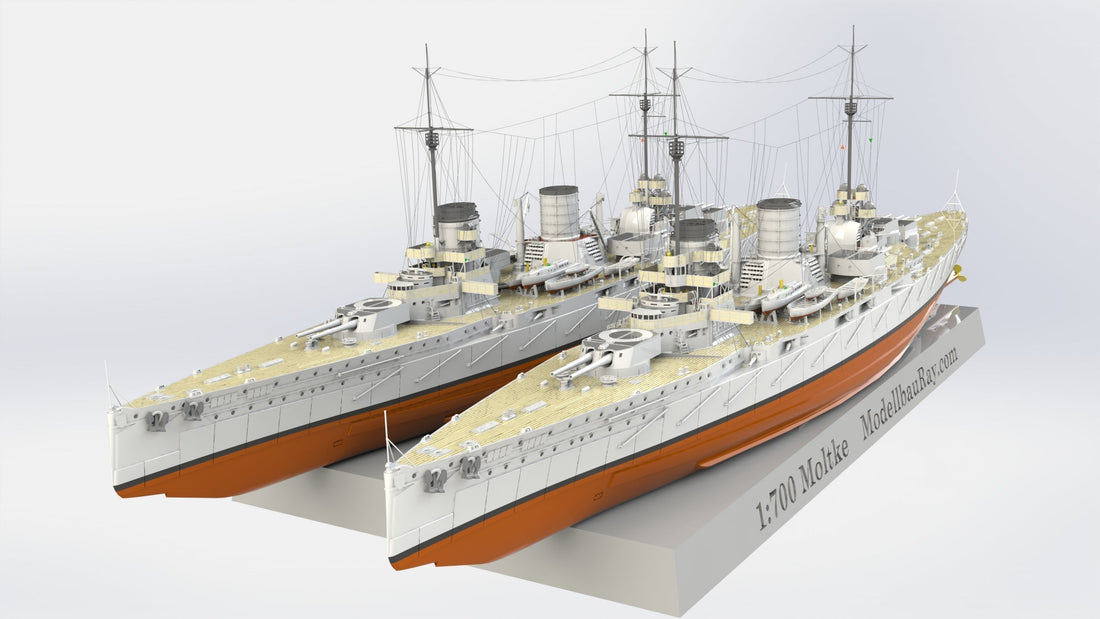Instructions, 1:700 SMS Moltke-Goeben 1915, 3D printed kit

Moltke-class battlecruiser was a key asset in Germany’s High Seas Fleet and saw significant action in the North Sea.
Goeben had a profound geopolitical impact, as its transfer to the Ottoman Empire helped bring the Ottomans into World War I on the side of the Central Powers.
Both ships exemplified the German philosophy of powerful, well-armed battlecruisers capable of outgunning most cruisers while outrunning battleships.
SMS Moltke
SMS Moltke was the lead ship of the Moltke-class battlecruisers, an improved version of the earlier Von der Tann. Launched in 1910 and commissioned in 1911, Moltke was named after Helmuth von Moltke the Elder, a prominent Prussian general.

Specifications and Design
Displacement: ~22,979 tons (standard), ~25,400 tons (full load)
Armament: 10 × 280 mm (11-inch) guns in five twin turrets
Speed: ~25.5 knots (47.2 km/h)
Armor: Up to 270 mm (10.6 inches) on the belt
As a battlecruiser, Moltke combined high speed with significant firepower, although its armor was thinner compared to contemporary battleships.

Operational History
Moltke took part in several key naval engagements during World War I, including:
The Bombardment of Scarborough, Hartlepool, and Whitby (1914)
The Battle of Dogger Bank (1915)
The Battle of Jutland (1916), where it suffered multiple hits but survived
Served in the High Seas Fleet until the end of the war
After Germany’s defeat, Moltke was interned at Scapa Flow and was scuttled by her crew in June 1919.
SMS Goeben
SMS Goeben was the second ship of the Moltke-class and was launched in 1911. Initially part of the German Mediterranean Division, Goeben played a crucial role in diplomatic and military events at the outbreak of World War I.

Operational History
In August 1914, Goeben and the light cruiser Breslau managed to evade British naval forces and reached Constantinople (Ottoman Empire).
To secure Ottoman support, Germany transferred Goeben and Breslau to the Ottoman Navy. Goeben was renamed Yavuz Sultan Selim and officially became part of the Ottoman fleet, though it remained crewed by Germans for much of the war.
Yavuz actively participated in Black Sea operations against Russia, bombarding ports and engaging Russian naval forces.
It remained in service with Turkey after the war and was not scrapped until 1973, making it one of the longest-serving battlecruisers in history.

This is a ship model developed by ModellbauRay Studio in 2025. It has a resin-cast hull and a 3D-printed superstructure. This ship model is very detailed, making it difficult to make and unsuitable for beginners. Of course, we also provided spare parts to this kit for easily damaged parts. Before starting please read the general instructions first.
General Instruction-How to build 3D printed kits
Our full-hull models are often delivered as one complete piece to simplify your work. You don't have to glue the upper and lower bottoms together, which usually creates seams that can take a lot of time to fix and damage the details of the model.

Sand the bottom of the ship model on a flat sandpaper to remove excess material.
After getting the bottom flat, use a flat-edge carving knife to remove the excess material. Then, polish the entire ship's bottom.

We recommend drilling holes before starting, to make it easier to hold. It is better to drill holes in the barbette and fix it with screws.



Below is the support design of the SMS Moltke. Removing the supports before detaching the towers from the skid is suggested.








Below is the support design of the SMS Goeben. Removing the supports before detaching the towers from the skid is suggested.








Below are the mast designs for the two ships, made using the copper pipes included in the kit.









































Use the 0.4mm copper tubes in the kit to make the anti-torpedo net support rods, a total of 28 pieces.




Rigging material is not included, it can be purchased separately.(Link here)
This kit includes water decals, please note they are not pre-cut decals, check the instructions below.



PE railings are not included, it can be purchased separately.(Link here)
It is recommended to spray paint the railing before installing it on the model.
Anchor chains can be purchased separately.(Link here)

Figurs are not included, you can make the scene more vivid by adding little figures. (Link here)







1 comment
What is the model dimendions
How can I order this model / SMS goeben